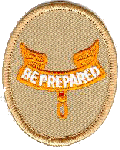These requirements became effective on January 1, 2008.
To see the requirements without the changes highlighted, Click here.
To see the previous requirements, Click here.
In the revisions below, the wording changes are shown as follows:
New text is in bold GREEN underlined Serif text like
this sentence.
Deleted portions are struck through RED italic text like
this sentence.
NOTE: These requirements may be worked on simultaneously with those for the Tenderfoot and First Class ranks; however these ranks must be earned in sequence.
-
- Demonstrate how a compass works and how to orient a map. Explain what map symbols mean.
- Using a compass and a map together, take a 5-mile hike (or 10 miles by bike) approved by your adult leader and your parent or guardian.*
-
- Since joining, have participated in five separate troop/patrol activities (other than troop/patrol meetings), two of which included camping overnight.
- On one of these campouts, select your patrol site and sleep in a tent that you pitched.
- On one campout, demonstrate proper care, sharpening, and use of the knife, saw, and ax, and describe when they should be used.
- Use the tools listed in requirement 2c to prepare tinder, kindling, and fuel for a cooking fire.
- Discuss when it is appropriate to use a cooking fire and a lightweight stove. Discuss the safety procedures for using both..
- Demonstrate how to light a fire and a lightweight stove.
- On one campout, plan and cook over an open fire one hot breakfast or lunch for yourself, selecting foods from the food pyramid. Explain the importance of good nutrition. Tell how to transport, store, and prepare the foods you selected.
- Participate in a flag ceremony for your school, religious institution, chartered organization, community, or troop activity.
- Participate in an approved (minimum of one hour) service project.
- Identify or show evidence of at least ten kinds of wild animals (birds, mammals, reptiles, fish, mollusks) found in your community.
-
- Show what to do for "hurry" cases of stopped breathing, serious bleeding, and internal ingested poisoning.
- Prepare a personal first aid kit to take with you on a hike.
- Demonstrate first aid for the following:
- Object in the eye
- Bite of a suspected rabid animal
- Puncture wounds from a splinter, nail, and fishhook
- Serious burns (partial thickness, or second degree)
- Heat exhaustion
- Shock
- Heatstroke, dehydration, hypothermia, and hyperventilation
-
- Tell what precautions must be taken for a safe swim.
- Demonstrate your ability to jump feetfirst into water over your head in depth, level off and swim 25 feet on the surface, stop, turn sharply, resume swimming, then return to your starting place.
- Demonstrate water rescue methods by reaching with your arm or leg, by reaching with a suitable object, and by throwing lines and objects. Explain why swimming rescues should not be attempted when a reaching or throwing rescue is possible, and explain why and how a rescue swimmer should avoid contact with the victim.
- Participate in a school, community, or troop program on the dangers of using drugs, alcohol, and tobacco, and other practices that could be harmful to your health. Discuss your participation in the program with your family.
- Participate in a school, community, or troop program on the dangers of using drugs, alcohol, and tobacco, and other practices that could be harmful to your health. Discuss your participation in the program with your family.
- Explain the three R's of personal safety and protection.
- Demonstrate scout spirit by living the Scout Oath (Promise) and Scout Law in your everyday life.
- Participate in a Scoutmaster conference.
- Complete your board of review.
* If you use a wheelchair or crutches, or if it is difficult for you to get around, you may substitute "trip" for "hike" in requirement 1b.
NOTE: Alternate Requirements for the
Second Class rank are available for Scouts with physical or mental
disabilities if they meet the criteria listed in the Boy Scout Requirements
book. (No. 33215).
(The substitution mentioned in the footnote to item 1b does NOT require the actions listed under that topic.)








